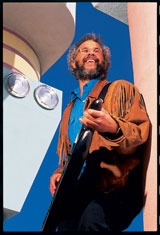|
|
We Play Requests |
June 2003 |
|
This month we're delighted to honor one of the most frequent requests we've received in the past couple of years: a comparison of selected software synthesizers with the vintage hardware instruments they emulate. I, too, have long been interested in this subject, but we bided our time before jumping in.
Why did we wait? Because we wanted to have just the right combination of interesting software; access to well-maintained, classic hardware; the correct environment for meaningful tests; and the right author. Thanks to author Brian Smithers and to owner of the Audio Playground Synthesizer Museum, Joseph Rivers ĺ─ţ and, of course, thanks to some amazing software-development efforts ĺ─ţ the pieces fell in place in recent months, and we were able to research the story the way we wanted to (see ĺ─˙Is It Real or Is It Emulatedĺ─¨ on p. 35).
Admittedly, comparing hardware with software emulations has its limitations. For starters, no two vintage analog instruments sound exactly alike. Sure, in a broad sense, a given model has its own identifiable sound. But put two Hammond B-3s or two Sequential Prophet-5 Rev 3s side by side, and you can usually hear subtle ĺ─ţ and sometimes not-so-subtle ĺ─ţ differences. An analog instrument's sound can be affected by many variables, some of which are difficult to identify, such as variations in a trace on a circuit board, components with the same value that don't operate exactly to spec, or a unit that is unusually temperature-sensitive. Furthermore, an analog instrument's sound depends on how you program it, or in the case of electromechanical instruments, how you adjust the mechanical parts.
Before moving forward with the story, therefore, we consulted with several experts in vintage electronic instruments, including long-time service technician and former EM ĺ─˙Service Clinicĺ─¨ column author Alan Gary Campbell, and Dave Smith, cofounder of Sequential Circuits (of Prophet-5 fame) and most recently the designer of the Evolver synth (reviewed on p. 110 of this issue). As Smithers writes, ĺ─˙ultimately, we realized that accounting for all possible variables was simply impossible; we needed to get over ourselves and be practical.ĺ─¨ He's right, of course, but with the understanding that we would attempt to account for variables that were at least partly within our control.
We also applied the Steve O Rat's Ass test. (I explained this test in my May 2002 column ĺ─˙Contemplating a Rat's Rear.ĺ─¨) In this case, we asked if, assuming the software versions sound great and come quite close to the sound of the hardware, who gives a rat's ass whether they sound identical to the hardware? My guess is that few projects require perfect emulations; in most cases, a great soft synth that captures the essence of the hardware's sound is sufficient, if not more than sufficient. As you will see, the soft synths we tested certainly achieve that, and many offer greater flexibility, if not features, than the original hardware.
Thanks to all of you who wrote us requesting this story and others like it; I am confident that you will enjoy the results. |
